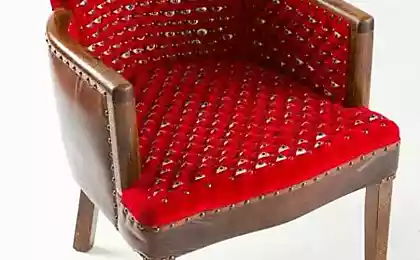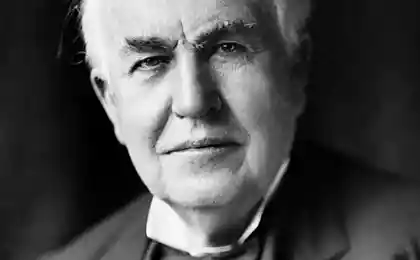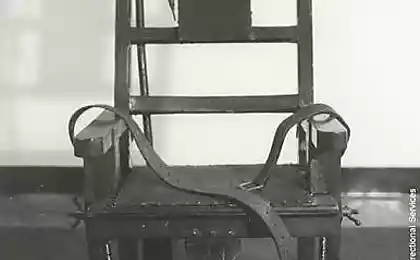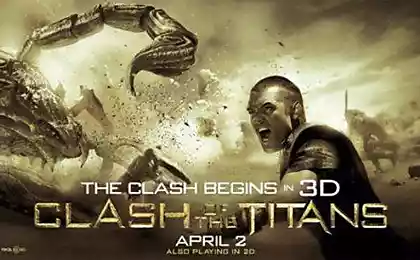2711
Clash of the Titans and the electric chair
At the end of the XIX century, Thomas Edison invented the incandescent bulb, which is truly a great invention, allowing the use of electricity for lighting cities ...
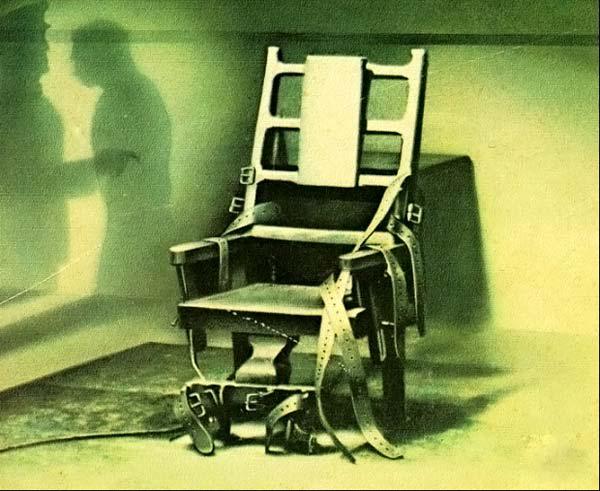
A dentist from Buffalo, New York, named Albert Southwick thought that electricity could be used in his medical practice as a pain reliever.
Southwick once saw one of the residents of Buffalo touch bare wires electric power station on the city and died as thought Southwick, almost instantly and painlessly.
This incident gave him the idea that the execution using electricity can replace hanging as a more humane and prompt punishment.
First Southwick talked with the head of the "Society for the protection of animals from cruelty," Kolonelom Rockwell, offering the use of electricity for getting rid of unwanted animals instead of drowning (a technique that has traditionally been used).
Rockwell liked this idea.
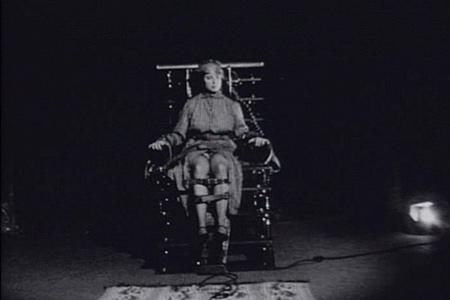
In 1882, Southwick began experiments on animals, publishing their results in scientific papers.
Southwick then showed the results to his influential friend, Senator David McMillan.
Southwick said that the main advantage of using electricity penalty is that it is painless and fleeting.
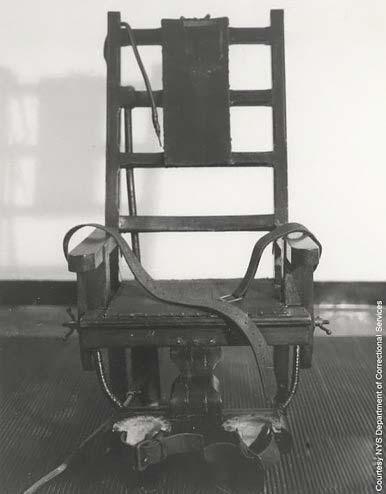
McMillan was a supporter of preserving the death penalty; drew his idea, as an argument against the abolition of the death penalty, because this kind of penalty can not be called cruel and inhumane, therefore, advocates the abolition of the death penalty will lose their most compelling arguments.
Macmillan gave a speech to the Governor of New York David Bennett Hill.
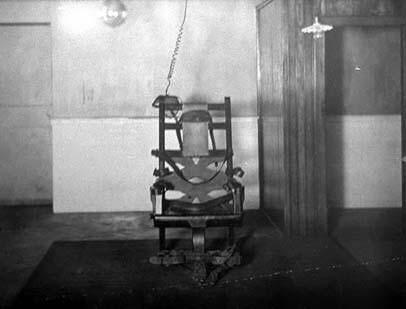
In 1886 adopted the "Law on the establishment of a commission to study and advice about the most humane and acceptable methods of enforcing the death penalty."
The commission included Southwick, Judge Matthew Hale and politician Elyuridzh Jerry.
Conclusion of the Commission set out to ninety-five pages of the report, was as follows: the best method for execution, the execution using electricity.
The report recommended that the state replace hanging on a new kind of penalty.
Governor Hill signed a law June 5, 1888, which was to come into force on January 1, 1889 and begin a new, humane punishment in New York State.

Had to solve the problem concerning the apparatus for enforcing a sentence, and the question of what type of electrical current should be used: DC or AC.
It is necessary to consider the history connected with AC and DC currents. How do they differ, and what is more suitable for the current execution?
Long before the invention of Thomas Edison, scientists from different countries working on this subject, but no one was able to use electricity in everyday life.
Edison realized in practice before it developed the theory.
Edison's first power station was built in 1879; almost immediately the representatives of different cities of the United States went to the scientist.
Edison's system, operating on direct current, has its difficulties.
Constant current flows in one direction.
DC injection is not possible for a long distance, it was necessary to build a power plant to provide electricity even medium-sized city.
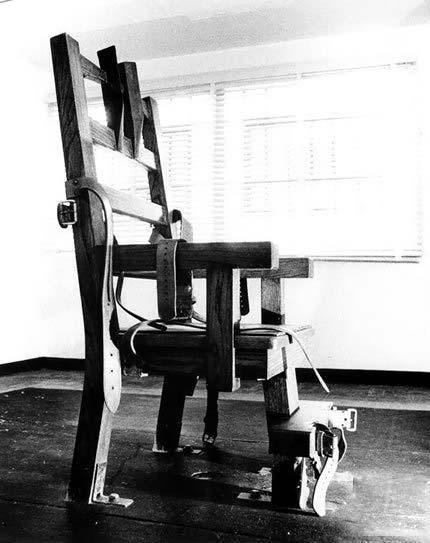
The solution was found by the Croatian scientist Nikola Tesla. He developed the idea of using alternating current.
Alternating current can change direction several times per second, creating a magnetic field, without losing the electric voltage.
Alternating voltage can be increased and decreased using transformers.
High voltage can be transmitted over long distances with little loss, and then, through the step-down transformer to bring electricity to consumers.
Some cities have used a system of alternating current (but not on the development of Tesla), and this system is to attract investors.

One such investor was George Westinghouse, known for his invention of the aerodynamic brake.
Westinghouse intended to make use of the AC profitable, but the technology DC Edison was more popular at the time. Tesla worked for Edison, but he paid no attention to its development, and Tesla resigned.
Soon after he patented his idea and was able prodemontrirovat them in action.
In 1888, Westinghouse bought forty patents from Tesla, and a few years more than a hundred cities have used a system of alternating current. Enterprise Edison beginning to take their positions.
It becomes apparent that the system will replace the AC DC system.
However, Edison did not believe it. In 1887 he began to discredit Westinghouse system by requiring their employees collecting information on deaths caused by alternating current, hoping to prove that its security system for the public.
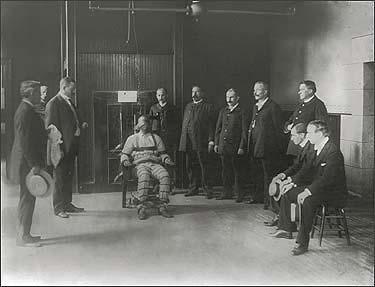
Clash of the Titans, is sometimes referred to as the story began when the question arose about the type of current that was to use the machine for the death penalty. Edison did not want his invention associated with death, he wanted the machine to the death penalty was applied alternating current.
In 1887 was published a brochure Edison "Warning" in which he compared with a variable DC and points to the first security.
June 5, 1888 in New York Evening Post published a letter from Harold Brown, who warned of the dangers of alternating current. This letter caused an alarmed reaction in society. In 1870, Brown was an employee of Edison, and we can assume that this letter was customized. In 1888, Brown conducted a series of experiments on animals, demonstrating the destructive capability of alternating current. In the experiments used two of the used alternator, as Westinghouse refused to sell their generators. Experiments were carried out over several dozen dogs, cats, over two horses.
The distinguished scientist Thomas Edison before the commission to address the method of execution has made a vivid impression.
Legendary inventor convinced everyone present that the death of electrical painless and quick, of course, in the case of alternating current.
The commission had the choice to enter into the application execution by lethal injection.
Lethal injection is considered more humane than the electric chair. In XX century, it began to use her almost all the states in which the death penalty.

Perhaps many would not have suffered the electric chair if there was no competition between campaigns or persuasive speech Edison before the commission, although the main issue was that the implementation of the execution by lethal injection should be done with the help of doctors or physicians themselves, which is impossible for obvious reasons.
The first execution took place on January 1, 1889.
A few decades after the event, this "unit" called Westinghouse chair or "vestingovannym» (Westinghoused).
The following executions took place in the spring 1891.
Four were executed for various crimes. The method of execution was corrected. The generator is now more powerful, Wire - thicker. The second electrode is not connected to the spine, and to the hand.
These executions took place more smoothly, and the new method was adopted by public opinion.
ervym 'tester' innovation was the murderer by the name Kemmsler. For understandable reasons, he could not describe my feelings, but witnesses executions noted that in 15 - 20 seconds after the first discharge the offender was still alive.
It was necessary to include current and higher voltage for a longer time.
Another long and hard "experiment" adjusted "to the end."
This execution caused many protests from the US and the world community.
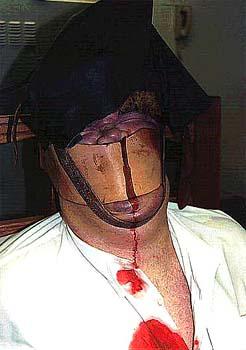
A technique of murder by electric chair is: criminal seated on a chair, tying him with leather straps and fastening wrists, ankles, hips and breasts.
Two copper electrodes are fixed to the body, one on the leg, the skin underneath is usually shaved for the best of the current, and the second is superimposed on top of his head shaved. Typically electrodes smeared with special gel to improve the holding power and reduce the burning of the skin.
On the face mask worn opaque.
The executioner presses the main switch on the control panel, giving a first voltage discharge 1700 - 2400 volts and a duration of 30 - 60 sec.
The time set on the timer in advance, and the current is switched off automatically. After 2 digits doctor examines the body of a criminal who may not have been killed by the previous discharge.
Death occurs as a result of cardiac arrest and respiratory paralysis.
However, modern Executioners came to the conclusion that the passage of current through the brain does not cause instant cardiac arrest (clinical death), but only prolongs the agony.
Now the criminals make cuts and injected electrodes in the left shoulder and right hip to rank just passed through the aorta and heart.
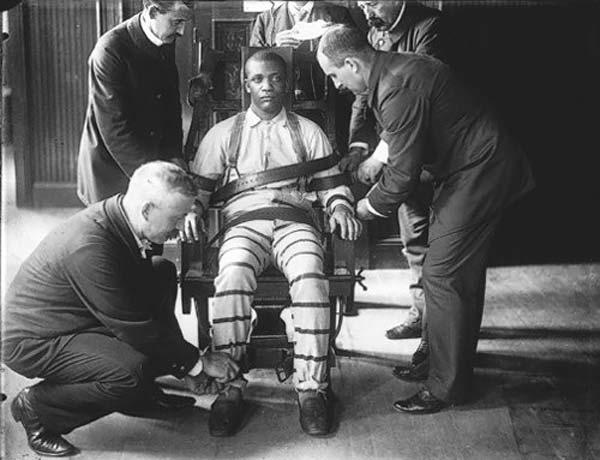
Although all methods of execution in one way or another cruel, but it is the electric chair characterized by frequent and tragic problem causing additional suffering convict, particularly in cases where the equipment is old and in need of repair.
All this has led to the fact that under the influence of the famous American human rights activist Leo Jones electric chair was recognized as "cruel, inapplicable" punishment, contrary to the US Constitution.
via vsiaco
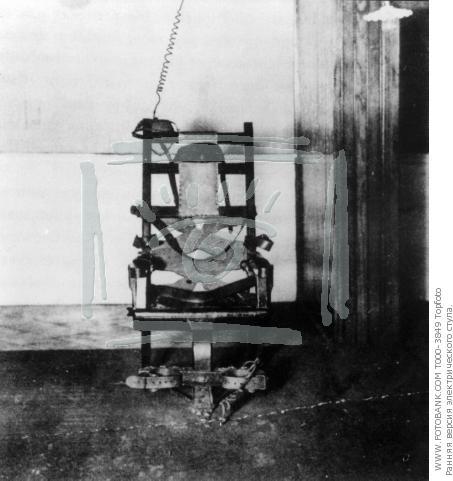
Source: http: //

A dentist from Buffalo, New York, named Albert Southwick thought that electricity could be used in his medical practice as a pain reliever.
Southwick once saw one of the residents of Buffalo touch bare wires electric power station on the city and died as thought Southwick, almost instantly and painlessly.
This incident gave him the idea that the execution using electricity can replace hanging as a more humane and prompt punishment.
First Southwick talked with the head of the "Society for the protection of animals from cruelty," Kolonelom Rockwell, offering the use of electricity for getting rid of unwanted animals instead of drowning (a technique that has traditionally been used).
Rockwell liked this idea.

In 1882, Southwick began experiments on animals, publishing their results in scientific papers.
Southwick then showed the results to his influential friend, Senator David McMillan.
Southwick said that the main advantage of using electricity penalty is that it is painless and fleeting.

McMillan was a supporter of preserving the death penalty; drew his idea, as an argument against the abolition of the death penalty, because this kind of penalty can not be called cruel and inhumane, therefore, advocates the abolition of the death penalty will lose their most compelling arguments.
Macmillan gave a speech to the Governor of New York David Bennett Hill.

In 1886 adopted the "Law on the establishment of a commission to study and advice about the most humane and acceptable methods of enforcing the death penalty."
The commission included Southwick, Judge Matthew Hale and politician Elyuridzh Jerry.
Conclusion of the Commission set out to ninety-five pages of the report, was as follows: the best method for execution, the execution using electricity.
The report recommended that the state replace hanging on a new kind of penalty.
Governor Hill signed a law June 5, 1888, which was to come into force on January 1, 1889 and begin a new, humane punishment in New York State.

Had to solve the problem concerning the apparatus for enforcing a sentence, and the question of what type of electrical current should be used: DC or AC.
It is necessary to consider the history connected with AC and DC currents. How do they differ, and what is more suitable for the current execution?
Long before the invention of Thomas Edison, scientists from different countries working on this subject, but no one was able to use electricity in everyday life.
Edison realized in practice before it developed the theory.
Edison's first power station was built in 1879; almost immediately the representatives of different cities of the United States went to the scientist.
Edison's system, operating on direct current, has its difficulties.
Constant current flows in one direction.
DC injection is not possible for a long distance, it was necessary to build a power plant to provide electricity even medium-sized city.

The solution was found by the Croatian scientist Nikola Tesla. He developed the idea of using alternating current.
Alternating current can change direction several times per second, creating a magnetic field, without losing the electric voltage.
Alternating voltage can be increased and decreased using transformers.
High voltage can be transmitted over long distances with little loss, and then, through the step-down transformer to bring electricity to consumers.
Some cities have used a system of alternating current (but not on the development of Tesla), and this system is to attract investors.

One such investor was George Westinghouse, known for his invention of the aerodynamic brake.
Westinghouse intended to make use of the AC profitable, but the technology DC Edison was more popular at the time. Tesla worked for Edison, but he paid no attention to its development, and Tesla resigned.
Soon after he patented his idea and was able prodemontrirovat them in action.
In 1888, Westinghouse bought forty patents from Tesla, and a few years more than a hundred cities have used a system of alternating current. Enterprise Edison beginning to take their positions.
It becomes apparent that the system will replace the AC DC system.
However, Edison did not believe it. In 1887 he began to discredit Westinghouse system by requiring their employees collecting information on deaths caused by alternating current, hoping to prove that its security system for the public.

Clash of the Titans, is sometimes referred to as the story began when the question arose about the type of current that was to use the machine for the death penalty. Edison did not want his invention associated with death, he wanted the machine to the death penalty was applied alternating current.
In 1887 was published a brochure Edison "Warning" in which he compared with a variable DC and points to the first security.
June 5, 1888 in New York Evening Post published a letter from Harold Brown, who warned of the dangers of alternating current. This letter caused an alarmed reaction in society. In 1870, Brown was an employee of Edison, and we can assume that this letter was customized. In 1888, Brown conducted a series of experiments on animals, demonstrating the destructive capability of alternating current. In the experiments used two of the used alternator, as Westinghouse refused to sell their generators. Experiments were carried out over several dozen dogs, cats, over two horses.
The distinguished scientist Thomas Edison before the commission to address the method of execution has made a vivid impression.
Legendary inventor convinced everyone present that the death of electrical painless and quick, of course, in the case of alternating current.
The commission had the choice to enter into the application execution by lethal injection.
Lethal injection is considered more humane than the electric chair. In XX century, it began to use her almost all the states in which the death penalty.

Perhaps many would not have suffered the electric chair if there was no competition between campaigns or persuasive speech Edison before the commission, although the main issue was that the implementation of the execution by lethal injection should be done with the help of doctors or physicians themselves, which is impossible for obvious reasons.
The first execution took place on January 1, 1889.
A few decades after the event, this "unit" called Westinghouse chair or "vestingovannym» (Westinghoused).
The following executions took place in the spring 1891.
Four were executed for various crimes. The method of execution was corrected. The generator is now more powerful, Wire - thicker. The second electrode is not connected to the spine, and to the hand.
These executions took place more smoothly, and the new method was adopted by public opinion.
ervym 'tester' innovation was the murderer by the name Kemmsler. For understandable reasons, he could not describe my feelings, but witnesses executions noted that in 15 - 20 seconds after the first discharge the offender was still alive.
It was necessary to include current and higher voltage for a longer time.
Another long and hard "experiment" adjusted "to the end."
This execution caused many protests from the US and the world community.

A technique of murder by electric chair is: criminal seated on a chair, tying him with leather straps and fastening wrists, ankles, hips and breasts.
Two copper electrodes are fixed to the body, one on the leg, the skin underneath is usually shaved for the best of the current, and the second is superimposed on top of his head shaved. Typically electrodes smeared with special gel to improve the holding power and reduce the burning of the skin.
On the face mask worn opaque.
The executioner presses the main switch on the control panel, giving a first voltage discharge 1700 - 2400 volts and a duration of 30 - 60 sec.
The time set on the timer in advance, and the current is switched off automatically. After 2 digits doctor examines the body of a criminal who may not have been killed by the previous discharge.
Death occurs as a result of cardiac arrest and respiratory paralysis.
However, modern Executioners came to the conclusion that the passage of current through the brain does not cause instant cardiac arrest (clinical death), but only prolongs the agony.
Now the criminals make cuts and injected electrodes in the left shoulder and right hip to rank just passed through the aorta and heart.

Although all methods of execution in one way or another cruel, but it is the electric chair characterized by frequent and tragic problem causing additional suffering convict, particularly in cases where the equipment is old and in need of repair.
All this has led to the fact that under the influence of the famous American human rights activist Leo Jones electric chair was recognized as "cruel, inapplicable" punishment, contrary to the US Constitution.
via vsiaco

Source: http: //











